Attached files
| file | filename |
|---|---|
| 8-K - FORM 8-K - LyondellBasell Industries N.V. | h85353e8vk.htm |
| EX-99.1 - EX-99.1 - LyondellBasell Industries N.V. | h85353exv99w1.htm |
Exhibit 99.2

| Third-Quarter 2011 Earnings Jim Gallogly, Chief Executive Officer Karyn Ovelmen, Chief Financial Officer Kent Potter, Principal Financial Officer Sergey Vasnetsov, SVP - Strategic Planning and Transactions Doug Pike, VP - Investor Relations October 28, 2011 |
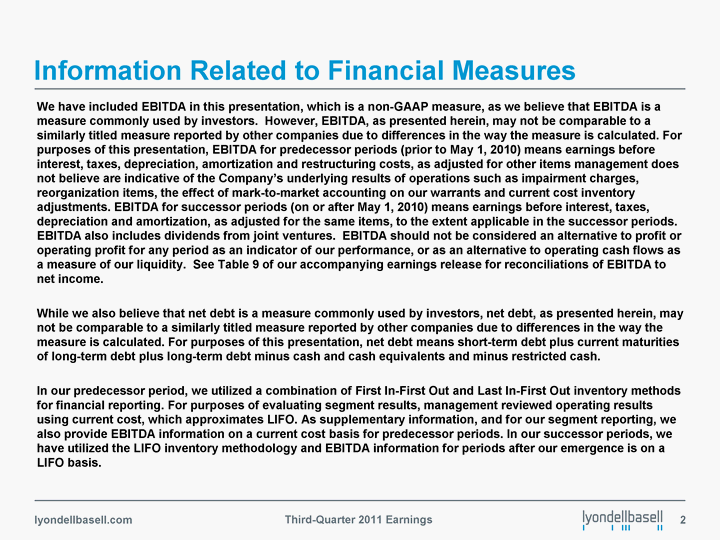
| Information Related to Financial Measures We have included EBITDA in this presentation, which is a non-GAAP measure, as we believe that EBITDA is a measure commonly used by investors. However, EBITDA, as presented herein, may not be comparable to a similarly titled measure reported by other companies due to differences in the way the measure is calculated. For purposes of this presentation, EBITDA for predecessor periods (prior to May 1, 2010) means earnings before interest, taxes, depreciation, amortization and restructuring costs, as adjusted for other items management does not believe are indicative of the Company's underlying results of operations such as impairment charges, reorganization items, the effect of mark-to-market accounting on our warrants and current cost inventory adjustments. EBITDA for successor periods (on or after May 1, 2010) means earnings before interest, taxes, depreciation and amortization, as adjusted for the same items, to the extent applicable in the successor periods. EBITDA also includes dividends from joint ventures. EBITDA should not be considered an alternative to profit or operating profit for any period as an indicator of our performance, or as an alternative to operating cash flows as a measure of our liquidity. See Table 9 of our accompanying earnings release for reconciliations of EBITDA to net income. While we also believe that net debt is a measure commonly used by investors, net debt, as presented herein, may not be comparable to a similarly titled measure reported by other companies due to differences in the way the measure is calculated. For purposes of this presentation, net debt means short-term debt plus current maturities of long-term debt plus long-term debt minus cash and cash equivalents and minus restricted cash. In our predecessor period, we utilized a combination of First In-First Out and Last In-First Out inventory methods for financial reporting. For purposes of evaluating segment results, management reviewed operating results using current cost, which approximates LIFO. As supplementary information, and for our segment reporting, we also provide EBITDA information on a current cost basis for predecessor periods. In our successor periods, we have utilized the LIFO inventory methodology and EBITDA information for periods after our emergence is on a LIFO basis. |

| Cautionary Statement The information in this presentation includes forward-looking statements. These statements relate to future events, such as anticipated revenues, earnings, business strategies, competitive position or other aspects of our operations or operating results. Actual outcomes and results may differ materially from what is expressed or forecast in such forward^looking statements. These statements are not guarantees of future performance and involve certain risks, uncertainties and assumptions that are difficult to predict. Factors that could cause actual results to differ from forward-looking statements include, but are not limited to, availability, cost and price volatility of raw materials and utilities; supply/demand balances; industry production capacities and operating rates; uncertainties associated with worldwide economies; legal, tax and environmental proceedings; cyclical nature of the chemical and refining industries; operating interruptions; current and potential governmental regulatory actions; terrorist acts; international political unrest; competitive products and pricing; technological developments; the ability to comply with the terms of our credit facilities and other financing arrangements; the ability to implement business strategies; and other factors affecting our business generally as set forth in the "Risk Factors" section of our Form 10-K for the year ended December 31, 2010, which can be found at www.lyondellbasell.com on the Investor Relations page and on the Securities and Exchange Commission's website at www.sec.gov. This presentation contains time sensitive information that is accurate only as of the date hereof. Information contained in this presentation is unaudited and is subject to change. We undertake no obligation to update the information presented herein except as required by law. |
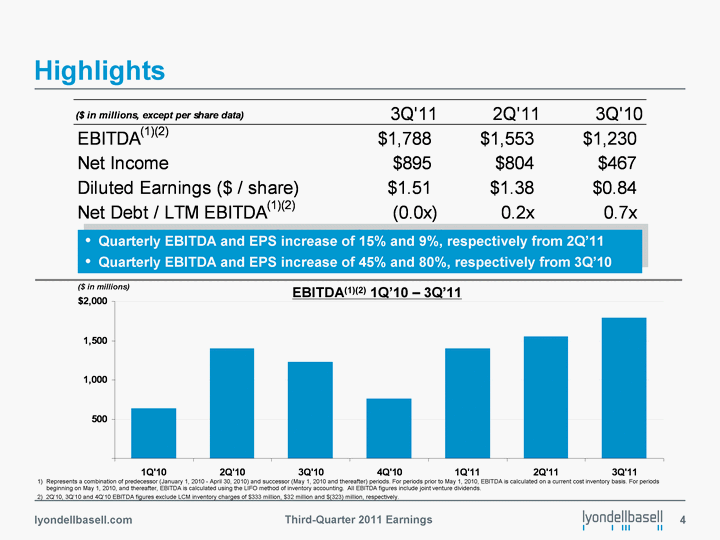
| Highlights EBITDA(1)(2) 1Q'10 - 3Q'11 1) Represents a combination of predecessor (January 1, 2010 - April 30, 2010) and successor (May 1, 2010 and thereafter) periods. For periods prior to May 1, 2010, EBITDA is calculated on a current cost inventory basis. For periods beginning on May 1, 2010, and thereafter, EBITDA is calculated using the LIFO method of inventory accounting. All EBITDA figures include joint venture dividends. 2) 2Q'10, 3Q'10 and 4Q'10 EBITDA figures exclude LCM inventory charges of $333 million, $32 million and $(323) million, respectively. Quarterly EBITDA and EPS increase of 15% and 9%, respectively from 2Q'11 Quarterly EBITDA and EPS increase of 45% and 80%, respectively from 3Q'10 ($ in millions) |

| Safety Performance Overall safety performance continues to improve and remains among the best in the industry 1) Includes employees and contractors. 2011 YTD as of September 30, 2011. Injuries per 200,000 Hours Worked(1) |
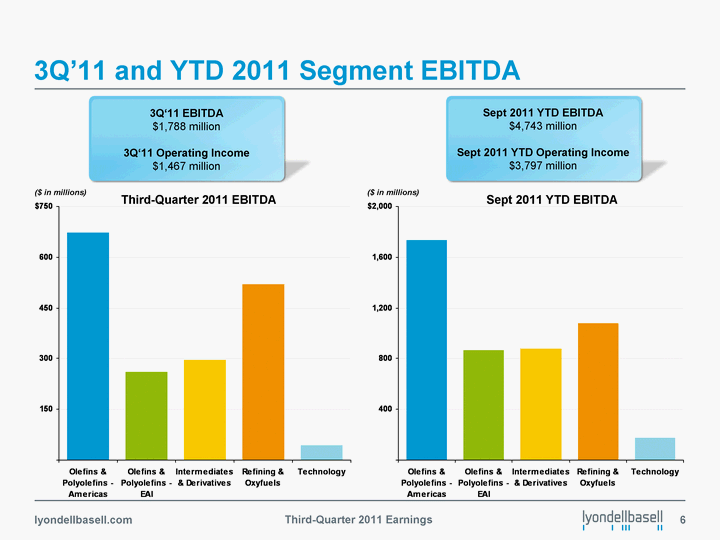
| Sept 2011 YTD EBITDA 3Q'11 and YTD 2011 Segment EBITDA Sept 2011 YTD EBITDA $4,743 million Sept 2011 YTD Operating Income $3,797 million 3Q'11 EBITDA $1,788 million 3Q'11 Operating Income $1,467 million Third-Quarter 2011 EBITDA ($ in millions) ($ in millions) |
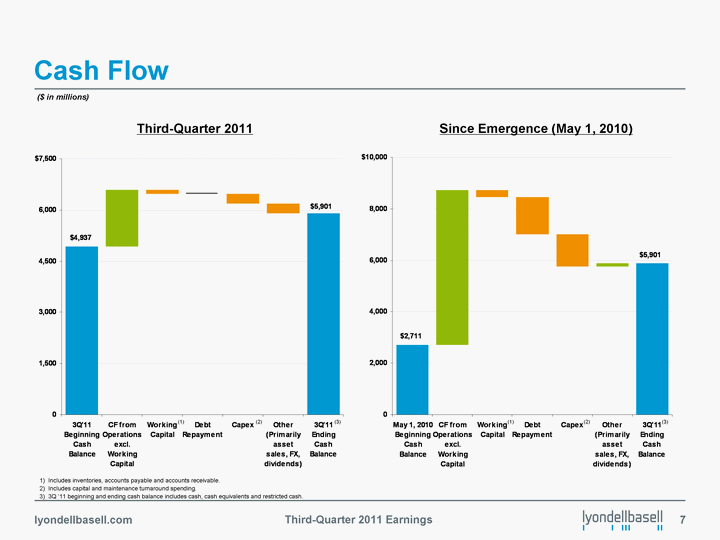
| Cash Flow 1) Includes inventories, accounts payable and accounts receivable. 2) Includes capital and maintenance turnaround spending. 3) 3Q '11 beginning and ending cash balance includes cash, cash equivalents and restricted cash. Third-Quarter 2011 Since Emergence (May 1, 2010) (2) (1) (3) ($ in millions) (2) (1) (3) |

| Working Capital and Liquidity Snapshot at September 30, 2011 Liquidity: ~ $7.9 billion Net Debt: ~ ($0.1) billion Cash: ~ $5.9 billion 1) Figures depicted represent end of quarter balances. ($ in billions) ($ in billions) Working Capital(1) Liquidity and Cash Balance |
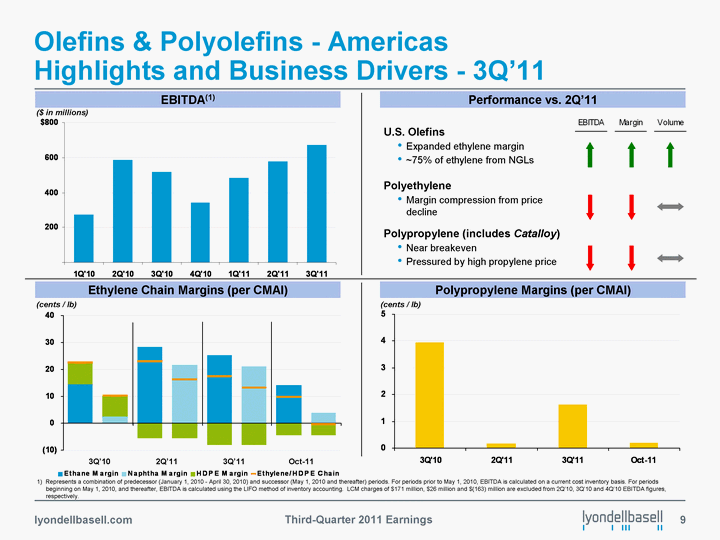
| 3Q'10 2Q'11 3Q'11 Oct-11 Olefins & Polyolefins - Americas Highlights and Business Drivers - 3Q'11 U.S. Olefins Expanded ethylene margin ~75% of ethylene from NGLs Polyethylene Margin compression from price decline Polypropylene (includes Catalloy) Near breakeven Pressured by high propylene price Ethylene Chain Margins (per CMAI) EBITDA(1) Performance vs. 2Q'11 Polypropylene Margins (per CMAI) 1) Represents a combination of predecessor (January 1, 2010 - April 30, 2010) and successor (May 1, 2010 and thereafter) periods. For periods prior to May 1, 2010, EBITDA is calculated on a current cost inventory basis. For periods beginning on May 1, 2010, and thereafter, EBITDA is calculated using the LIFO method of inventory accounting. LCM charges of $171 million, $26 million and $(163) million are excluded from 2Q'10, 3Q'10 and 4Q'10 EBITDA figures, respectively. ($ in millions) (cents / lb) (cents / lb) |
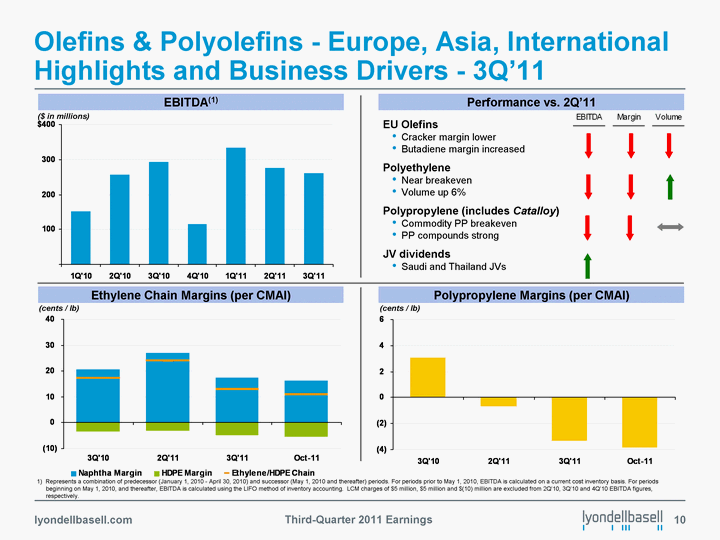
| Olefins & Polyolefins - Europe, Asia, International Highlights and Business Drivers - 3Q'11 EU Olefins Cracker margin lower Butadiene margin increased Polyethylene Near breakeven Volume up 6% Polypropylene (includes Catalloy) Commodity PP breakeven PP compounds strong JV dividends Saudi and Thailand JVs Ethylene Chain Margins (per CMAI) EBITDA(1) Performance vs. 2Q'11 Polypropylene Margins (per CMAI) 1) Represents a combination of predecessor (January 1, 2010 - April 30, 2010) and successor (May 1, 2010 and thereafter) periods. For periods prior to May 1, 2010, EBITDA is calculated on a current cost inventory basis. For periods beginning on May 1, 2010, and thereafter, EBITDA is calculated using the LIFO method of inventory accounting. LCM charges of $5 million, $5 million and $(10) million are excluded from 2Q'10, 3Q'10 and 4Q'10 EBITDA figures, respectively. ($ in millions) (cents / lb) (cents / lb) |

| Intermediates & Derivatives Highlights and Business Drivers - 3Q'11 1) Represents a combination of predecessor (January 1, 2010 - April 30, 2010) and successor (May 1, 2010 and thereafter) periods. For periods prior to May 1, 2010, EBITDA is calculated on a current cost inventory basis. For periods beginning on May 1, 2010, and thereafter, EBITDA is calculated using the LIFO method of inventory accounting. LCM charges of $25 million and $(17) million are excluded for 2Q'10 and 4Q'10, respectively. EBITDA(1) Propylene Oxide and Derivatives Continued strong results Margin expansion Particular strength in solvents and butanediol Intermediates Generally steady underlying results 2Q'11 included a gain from silver catalyst sale Performance vs. 2Q'11 ($ in millions) |

| Refining & Oxyfuels Highlights and Business Drivers - 3Q'11 Houston Refinery Crude throughput: 269 MBPD Maya 2-1-1: $23.53 / bbl Crude optimization Berre Refinery Crude throughput: 79 MBPD Urals 4-1-2-1: $8.76 / bbl Oxyfuels Seasonal margin decline in later part of quarter Refining Spreads (per Platts) (2) EBITDA(1) Performance vs. 2Q'11 EU MTBE Raw Material Margins (per Platts) 1) Represents a combination of predecessor (January 1, 2010 - April 30, 2010) and successor (May 1, 2010 and thereafter) periods. For periods prior to May 1, 2010, EBITDA is calculated on a current cost inventory basis. For periods beginning on May 1, 2010, and thereafter, EBITDA is calculated using the LIFO method of inventory accounting. LCM charges of $132 million, $1 million and $(133) million are excluded from 2Q'10, 3Q'10 and 4Q'10 EBITDA figures, respectively. 2) Light Louisiana Sweet (LLS) is the referenced light crude. ($ in millions) ($ / bbl) 3Q'10 2Q'11 3Q'11 Oct-11 (cents / gallon) |

| Technology Highlights and Business Drivers - 3Q'11 Continued strong catalyst results Third-Quarter 2011 Results $45 million EBITDA Hostalen Technology |

| Third-Quarter Summary and Outlook Ethane cracking remains advantaged vs. naphtha, although Gulf Coast profit margins anticipated to be lower in 4Q'11 vs. 3Q'11 Midwest margins remain very strong Volatile pricing in olefins chain, particularly co-products Seasonal impacts including: Refining and oxyfuel margins Potential end-of-year polymer sales slowdown Advancing capital structure per October 20, 2011 press release Near-term Outlook Record quarterly earnings Continued strong performance across all segments Continued to benefit from differentiated positions such as: Midwest crackers Houston Refinery Propylene oxide PP compounding Joint ventures Dividend increased to $0.20 / share Third-Quarter Summary |
